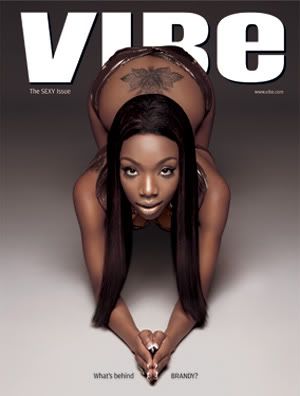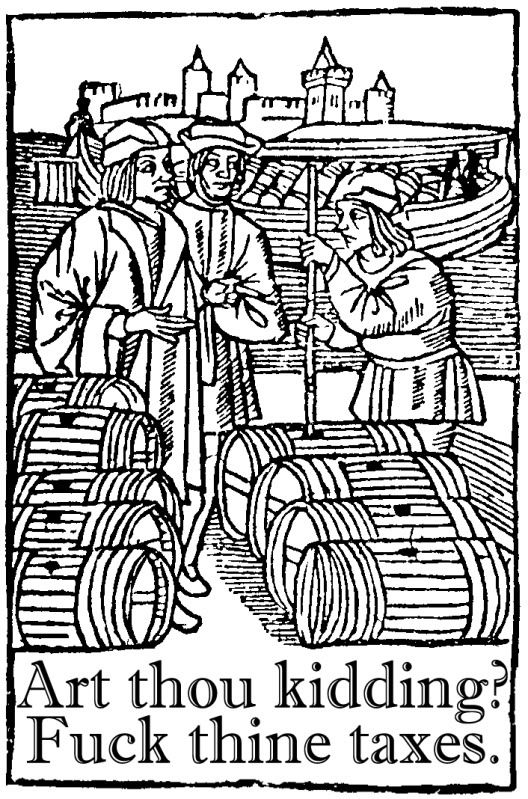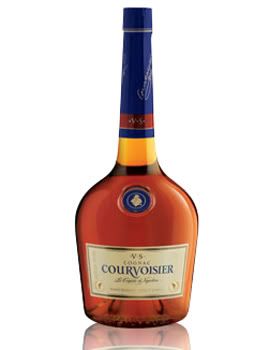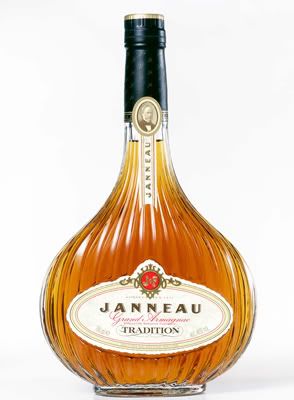 |
The difference between the method for making wine and the method for making whisky is essentially the same as the difference between baking and frying. There is, however, a sort of hybrid between the two that you've probably heard of.
What the Fuck is Brandy?
 To understand what brandy is you need to understand the difference between fermentation and distillation. Fermentation is simple: yeast interacts with sugar to produce ethanol, which gets you drunk. Many popular alcohols are made in this way, including beer (fermented starches ranging from barley to rice), wine (fermented grapes), and mead (fermented honey). Distillation is the process by which you concentrate alcohol and other good bits from a fermented mixture. This is how you get rum (distilled sugar), whisky (distilled starches), and tequila (distilled blue agave). Basically, fermentation makes it alcoholic while distilling makes it super alcoholic.
To understand what brandy is you need to understand the difference between fermentation and distillation. Fermentation is simple: yeast interacts with sugar to produce ethanol, which gets you drunk. Many popular alcohols are made in this way, including beer (fermented starches ranging from barley to rice), wine (fermented grapes), and mead (fermented honey). Distillation is the process by which you concentrate alcohol and other good bits from a fermented mixture. This is how you get rum (distilled sugar), whisky (distilled starches), and tequila (distilled blue agave). Basically, fermentation makes it alcoholic while distilling makes it super alcoholic.So, finally answering the fucking question: Brandy is distilled wine. Basically, it's like whisky made with grapes. It tastes very earthy and smokey, like a good scotch, but with an undeniable sweetness. It isn't for the amateur drinker, no matter what Young Jeezy would have you believe.
This History of Brandy or Fucking The Government Never Tasted so Good
 Ever since early man discovered fermentation, he's been making wine. Likewise, distilled wine (brandy) has been around for as long as distillation, which is thought to have first been used widely in Greece, circa 1 A.D. It wasn't until the twelfth century, however, that modern brandy was developed by the same brilliant booze makers that brought us champagne: the shipping industry. Wine was initially distilled to aid in shipping. The thought was: distill all the water out of the wine so you can transport more, then just add the water back in when it got where it was going. Plus, since taxes were levied by volume, concentrating the wine really cut down on what you had to pay. History's first tax loophole was born.
Ever since early man discovered fermentation, he's been making wine. Likewise, distilled wine (brandy) has been around for as long as distillation, which is thought to have first been used widely in Greece, circa 1 A.D. It wasn't until the twelfth century, however, that modern brandy was developed by the same brilliant booze makers that brought us champagne: the shipping industry. Wine was initially distilled to aid in shipping. The thought was: distill all the water out of the wine so you can transport more, then just add the water back in when it got where it was going. Plus, since taxes were levied by volume, concentrating the wine really cut down on what you had to pay. History's first tax loophole was born.Naturally, the first thing people did when they got their hands on distilled wine was drink it. Thanks to its time spent stored in oak barrels, the brandy was actually better tasting than the wine it was derived from. It also didn't hurt that adding water to the brandy as planned didn't make it taste a fucking thing like wine (distilling doesn't work that way, which I'll explain below).
Distillation: Not Just for the Inbred
When you think of a still, you probably think of something that looks like this picture. That's a classic American moonshine still, plucked from some redneck's backyard where it lived between a '73 Trans Am on blocks and the remnants of a meth lab. You've undoubtedly seen them in movies, which is why I'm using one to explain how distilling works. Distilling beverages is one of few technologies that has been pretty much perfected... in the 8th century. Outside of a few techniques for distilling huge amounts of liquid, the process hasn't changed much.
If you can understand boiling, you can understand distilling. Basically it's the process by which a mixture (in this case, alcohol trapped in a fermented stock) is separated out by boiling. You heat the mixture to a specific degree, at which parts of it begin to boil and become vapor. The vapor is collected and separated from the original mixture, then cooled back into a liquid. Here's the process using the photo above as a guide.
The fermented stock is boiled in a vat (A) This stock is often called a wash, though various producers have different names for it. As the wash heats up, water, alcohol, and aromatics begin to boil and become vapor. This vapor enters the tube (B) at the top, also know as a condenser. The condenser is meant to carry your now distilled spirit to the distillate (E). The only problem, at this point, is that your spirit isn't exactly water... that requires cooling. The condenser winds around the barrel (C) which is filled with cold water. This cools the vapor back into a liquid, which is then pushed into the distillate. You'll notice the copper condenser (D) gets all twisty there at the end. As the liquid passes through, it reacts to the metal which kills the last of the undesirable leftovers.
When making brandy, the wash is called low wine, and it's distilled twice. The first and last bit of the distilled product is discarded, which rids it of some initial foul odors and chemicals which burn off faster than the rest. The finished product is brandy, but it's actually clear. To get the familiar amber color, it's either oak aged (the good stuff) or colored. You'll note that far more than just water is separated from the brandy during distilling, which is why those French tax cheats' plans didn't pan out.
Types of Brandy
Technically speaking, only spirit distilled from wine is brandy. However, drinks distilled from other fruit often carry the brandy name (usually after their base fruit as in peach brandy, apricot brandy, e.t.c.)
Cognac
Cognac is brandy made in the region of eastern France surrounding the city of the same name. Cognac is considered the gold standard in brandy much like champagne is for sparkling wines. It is derived from extremely dry, undrinkable white wine and distilled in traditional copper pot stills a batch at a time (as opposed to continuous distilling, which distills liquid as it is inserted, assembly-line style) and aged in oak barrels for at least two years. The production of cognac is tightly regulated, and it has its own grading system: VS for Very Special, which is the youngest cognac, VSOP for Very Special Old Pale, which is at least four years old, and XO for Extra Old, which is at least six but commonly more than 20 years old. Needless to say, cognac is extremely pricey. Probably the most famous brands are Courvoisier and Hennessy, which were the rapper's beverage of choice before Cristal and purple drank rose to prominence due to their more desirable effects when poured on some bitches. South African brandy, though not called cognac, is made in the same style and under the same regulations, producing a similarly fine beverage.
Armagnac
Armagnac is shockingly named for the region of... you guessed it... France from which is comes. What is it about the fucking French? This was one of the first places to actually produce brandy worldwide, and the first French region period. Due to the popularity of cognac, armagnac production is relegated to small distillers. It's famous for once being promoted as medicinal with "40 virtues" curing everything from gout to hepatitis. Come to find out, it actually does have some impact on lowering cardiovascular disease, but that's about it.
 Applejack
ApplejackMade from apple cider (so not technically brandy), applejack is a uniquely American beverage. It was created and popularized during the colonial era and was once used as currency in New Jersey. Applejack is usually freeze distilled (basically distilling using freezing points and not boiling points). Applejack (aka Jersey Lightning) is a personal favorite of mine.
Tsipouro
 This Greek spirit is made from the residual grapes left over after pressing wine (called the pomace) which is pressed further and combined with stems and seeds (called the must). It was created by history's greatest drinkers: orthodox monks! It's served as a deep chilled shot and drank at celebrations and festivals. It has a lighter taste than traditional brandy. Tsipouro was the precursor to Ouzo and is occasionally flavored with anise (that licorice tasting stuff).
This Greek spirit is made from the residual grapes left over after pressing wine (called the pomace) which is pressed further and combined with stems and seeds (called the must). It was created by history's greatest drinkers: orthodox monks! It's served as a deep chilled shot and drank at celebrations and festivals. It has a lighter taste than traditional brandy. Tsipouro was the precursor to Ouzo and is occasionally flavored with anise (that licorice tasting stuff).And that's the world of brandy! If you're a wine drinker, I urge you to give brandy a shot, especially after a good meal, but take it easy or you'll quickly find yourself on the wrong side of drunk. One last thing: you can drink brandy either warm or cold... it varies depending on the culture. Anyone who tells you there is a right way and a wrong way is a goddamn moron. Have fun!






um, yum, brandy....I'm going to have to get some of the Applejack for The Man to try.
ReplyDeleteIt really is excellent. It has a very great, mellow whisky-like flavor with next to no burn and incredible smoothness. I like to cut it with just the slightest bit of apple juice or cider to really bring out the subtle flavor.
ReplyDeleteMmmm, I've always enjoyed a small glass of brandy now and then. Funny about the Cognac rating system, the French love having a lot of individualized regulations and rating systems for every type of quality food product, including the exact percentage of curds in the cheesemaking process. I can only imagine the inspections days at the brandy makers.
ReplyDeleteNever tried apple jack before, but it sounds like a good idea.